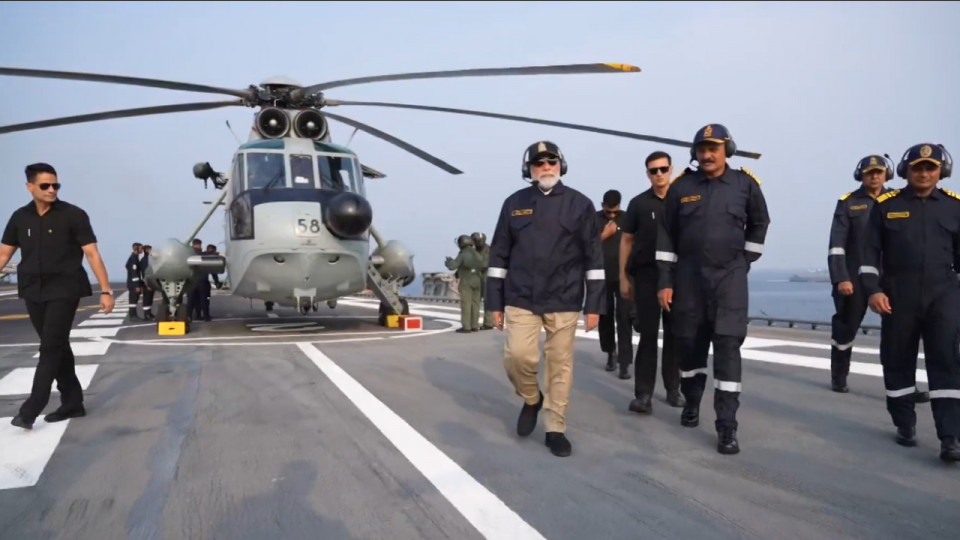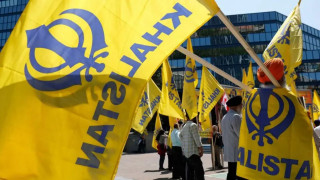
From Karachi to Gwadar, PM Modi’s INS Vikrant Message Reveals India’s Naval Dominance Over Pakistan (Image Source: Screengrab from BJP X account/ @BJP4India)
International News: In the 1971 war, when the Indian Navy bombed Karachi Port, fires burned for almost a week. During Operation Sindoor, Pakistan moved some of its warships near the Iranian border and others to Gwadar Port to escape Indian attacks. Since then, Pakistan has always feared India’s strong presence in the Arabian Sea. This time, Prime Minister Narendra Modi celebrated Diwali at sea with the Indian Navy. It was his 12th Diwali with the armed forces but the first with the Navy, a move that carried a special message for Pakistan.
PM Modi’s visit to INS Vikrant and his Diwali celebration with naval officers was not just symbolic. It was a clear and strong political message aimed at Pakistan’s military headquarters in Rawalpindi. Defense journalist Sandeep Unnithan, writing in India Today, described it as a major strategic signal to Pakistan. While addressing the officers on board, Modi said, “Just a few months ago, the name INS Vikrant sent waves of fear across Pakistan. That’s its power — a name that breaks the enemy’s courage.”
Satellite images revealed that during the clashes in May, the Pakistan Navy had vacated its usual bases at Karachi and Ormara. Their warships were moved to civilian ports and Gwadar, which is operated by China. This happened because around 300 nautical miles south, India’s Vikrant Carrier Battle Group was deployed, supported by four escort ships armed with BrahMos missiles. Reports suggest that if the ceasefire on May 10 had not been announced, a direct attack on Karachi Port would have followed soon after — all that was missing was the final order. Sandeep Unnithan wrote that if India had attacked Pakistan’s 1,000-km coastline, the economic and strategic impact would have been huge. Foreign ships would have avoided Pakistani ports, oil supplies would have stopped (Pakistan imports 500,000 barrels of oil daily), and with only 10–20 days of storage, the country would have faced a severe energy crisis. A naval blockade by India would have nearly turned Pakistan into a landlocked nation, forcing it to depend completely on Iran, Afghanistan, and China for energy imports.
Pakistan’s biggest challenge is its geography and limited naval strength. Its coastline along the Arabian Sea is narrow, with very few exit routes. Compared to India, Pakistan’s navy is smaller and less advanced in both numbers and technology. During the recent Operation Sindoor, the Indian Air Force destroyed an American surveillance radar near Karachi’s Malir Cantonment, leaving Pakistan’s naval deployment almost useless. Experts believe that in wartime, Pakistan’s navy would struggle to take its ships out of ports, effectively paralyzing its maritime activities. While the navy can conduct drills and anti-piracy missions in peacetime, it would be nearly ineffective in any direct conflict with India.
In the 1971 war, India’s Navy had crushed Pakistan’s naval strength. Within two weeks, Indian forces sank several Pakistani ships near Karachi, including PNS Khaibar, PNS Muhafiz, and MV Venus Challenger, leaving Pakistan’s western fleet crippled. In the east, INS Vikrant led operations that blocked the escape routes for Pakistani forces in what is now Bangladesh. By celebrating Diwali aboard INS Vikrant, Modi reminded Pakistan that history could repeat itself. Once again in 2025, Pakistan’s warships seem to be hiding at ports like Gwadar and Pasni. Reports say Field Marshal Asim Munir is trying to allow the U.S. to use the Pasni Port, a move to shield Pakistan’s navy during war. With America at Pasni and China at Gwadar, Pakistan hopes to protect itself from India’s naval might but Modi’s message from the sea makes it clear that India is ready for any challenge.













Copyright © 2025 Top Indian News
